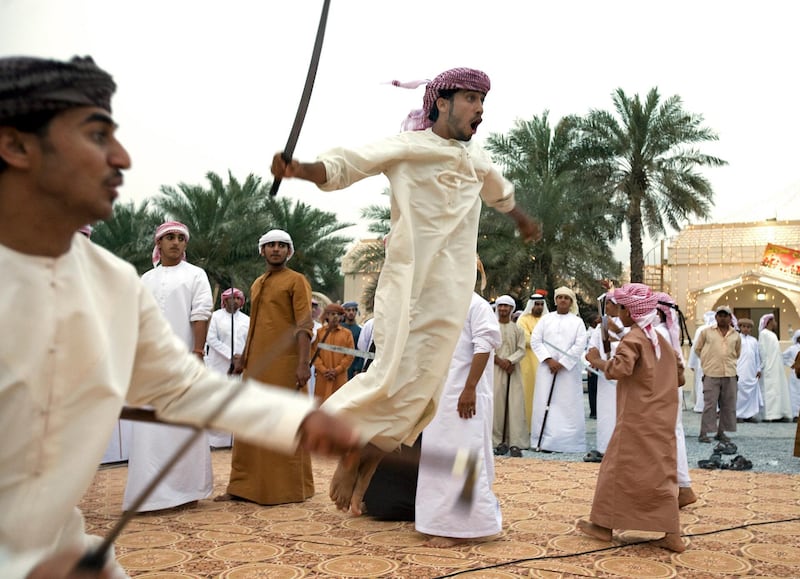In the Ru'us Al Jibal mountains of Oman and the UAE, a wedding isn't a wedding without sword throwing. When a guest arrives at a wadi wedding, the first thing they will hear is the nadbah - a shriek that is both war cry and greeting.
The first thing a guest will see is the glint of swords flipping through the air. Boys spring from foot to foot, tossing blades upwards, as male guests approach a reception line of hosts ready to shake hands and bump noses – a welcome between old friends.
Swords remain an essential wedding accessory. In the old town of Ras Al Khaimah, a handful of silversmiths continue to sell the traditional straight sword.
Sahar Naseer, 27, a smith whose family founded Shams Gold & Silver Works in the 1980s, sells an average of six to 10 a month.
_______________
Read more: Heritage in the Northern Emirates
Sleep Ras Al Khaimah street is reinvigorated with a shot of karak
UAE's Shehhi dialect at risk of disappearing, scholars say
Raging bulls connect with past
_______________
“In maybe the last seven or eight years sales have become less,” Mr Naseer said. “It is getting more expensive day by day. The labour, the silver and the cost is getting expensive.”
Light swords used by teenagers sell for Dh100, while decorative silver swords sell for up to Dh1,400. No registration is needed by buyer or seller.
"Swords will be used for school and dancing in ceremonies," Mr Naseer said. He does not sell to teenagers unaccompanied by parents.
Swords once served practical purposes, but today's blades are blunt, all the better to deftly balance on fingertips while dancing the razfa – a whirl of men dancing with canes, swords, rifles and the jerz, a traditional short-bladed axe.
“We start carrying the sword when we are maybe four years old, when we are at weddings and special occasions,” said Mohammed Ali, a sword dancer from the Ras Al Khaimah town of Khatt.
Mr Ali, 28, started dancing with his father’s sword when he was almost as tall as the sword was long.
He owns three swords, his father's blade, his great-great grandfather's sword and a sword he won at a competition in Fujairah.
"Originally they were used for wars and carried when people would go to the mountains to protect them from animals or to clear trails," Mr Ali said. "People carried swords to keep them safe from danger. Of course nowadays, the Shehhi tribe has a special match called mzafin that shows the power and skills of the tribe."
In the mzafin, a tradition of Ru'us Al Jibbal tribes, sword-wielding dancers leap at each other in mock battle. Its popularity inspired a 2010 reality TV show in Fujairah, Al Saif Traditional Sword Competition, where viewers voted for their favourite sword dancer by SMS.
During the finale, teenager Hazza Sulaiman of Dibba set a Guinness World Record for sword throwing when he launched his blade 21 metres into the air before catching it in his hands, proving that a man who can master his sword is a cut above.






